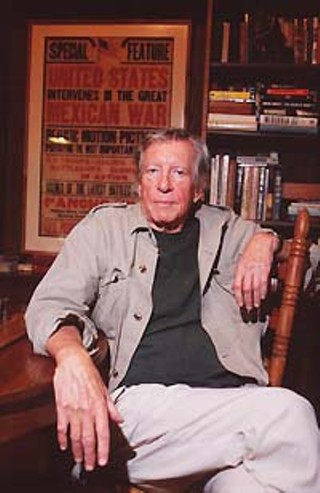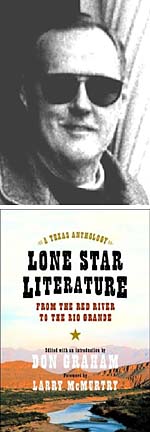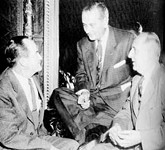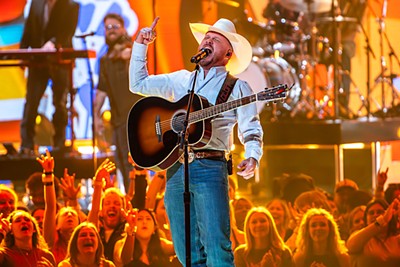Blessed Deliverance
The Borderland, Bud Shrake's Latest Tall Tale
By Dick Holland, Fri., March 31, 2000

The Borderland: A Novel of Texas
by Edwin ShrakeHyperion, 416 pp., $24.95
Bud Shrake's The Borderland follows so closely on the heels of Stephen Harrigan's The Gates of the Alamo that the reader of Texas fiction could almost believe that there is some deep serendipity at work. Both novels are set in the Texas of the late 1830s, and both are books long in coming that rise to the top of the works produced by these two gifted writers. Harrigan's widely lauded narrative is knocking on the door of the bestseller lists and deservedly so, but now that Shrake's book is here, it becomes apparent that early in this literary year we have been twice blessed. The Borderland takes place during the first nine months of 1839, three years after the main events of Harrigan's novel end. In many ways that period of Texas history was more unsettled than the spring of 1836 that culminated in the seige of the Alamo, the slaughter at Goliad, and the surprising Texian victory over Santa Anna at San Jacinto. At least the experience of armed battle against Mexico was somewhat unifying -- by the time Shrake's novel opens, the reality of governing an unstable and very vulnerable just-born Republic of Texas has hit, and the future of the fledgling state is in great doubt. The wild and wooly Sam Houston has been replaced as president of the Republic by Mirabeau B. Lamar, an effete poet who has bought into the idea of expanding the Republic to the west, at least to Santa Fe. Toward this end, Lamar is moving the capital of the Republic from the malarial swamps of Houston to the Colorado River village of Austin, where roving bands of Comanches are camped out just beyond the banks of Shoal Creek.
The prologue of The Borderland begins with four Comanche leaders -- Fighting Man, Talking Man, Thinking Man, and Dark Man -- looking down at the new Anglo settlement from a cave on the west bank of the Colorado River:
This valley had been a holy place since the beginning of the families on earth. Now these invaders called Texans -- the men with hats -- had marched into the valley with threats and insults and had begun building structures that looked to be intended as permanent. The families had become uneasy in their camps a hundred and more miles west in the hills and forests of Comancheria. They had been at war against Mexico for generations and had strewn the land with dead Mexicans and stolen hundreds of thousands of Mexican horses and taken thousands of Mexican captives as slaves or for trade. But these new invaders with hats were becoming a more sinister enemy than the Mexican army.
Shrake's ease at creating a plausible reality for the Comanche nation reminds us of his masterful 1968 novel Blessed McGill, a work that seamlessly balanced the life of the questing frontiersman McGill with the funk and exoticism of Comanche life.
In the new novel we soon meet three of the four primary characters: Dr. Romulus Swift, his beautiful and soulful sister Cullasaja, and Ranger Captain Matthew Caldwell, a confidant to everyone in a position of power in the Republic. The Swift siblings are the children of a North Carolina purebred Cherokee mother and an Irish sea captain father. Romulus, or "Doc Swift" (they are purportedly related to Jonathan Swift on their father's side), passes for white and was the bare-knuckle boxing champion at the University of Edinburgh, where he studied medicine. The dark-skinned Cullasaja embodies the folk wisdom and love of nature of the Cherokees, who are trying to settle land in East Texas promised them by Sam Houston. Matthew Caldwell is a widower who, soon after his arrival in Austin, hooks up with a marriage broker. Early frontier Austin is seen through the eyes of these new arrivals:
Doc and Cullasaja enjoyed walking in Austin. ... The north and south streets were named for the biggest Texas rivers -- Rio Grande, Nueces, San Antonio, Guadalupe, La Baca, Colorado, Brazos, San Jacinto, Trinity, Neches, Red River and Sabine. ... West Avenue was the western boundary of the city and East Avenue was the eastern edge. Waller Creek defined the eastern boundary and Shoal Creek ran along the western. Both creeks flowed steadily year after year, even during times of no rain. ...The twenty streams that flowed through the city were lined with cypress, cottonwood and sycamore trees. Oaks, hackberries, chinaberries, elm and willows grew in abundance. ... In and around the city were rabbits, possums, squirrels, raccoons, foxes, armadillos, roadrunners, pigeons, pheasants, wild turkeys, coyotes, wolves, panthers, otters, beavers, hawks, and often a bear or an eagle would be seen.

Shrake populates this watery paradise with a cast of characters worthy of his legendary Seventies Dennis Hopper film, Kid Blue. Leading the way are Bone, a randy lawyer who is brutally emasculated during a Comanche attack on Barton Creek, and the German landbroker Gruber, who has a Comanche war ax blade sticking out of the back of his head because no doctor dares remove it. Doc Swift and Cullasaja combine the best European medicine with traditional Cherokee remedies with a lot of opium tossed in and soon make themselves invaluable to Austin's raucous community. Adding to Shrake's magic realism laced with opium is Gruber's story of a cave filled with gold, guarded by a half ape/half man located deep in the heart of Comancheria.
We meet the fourth leading character in the form of a letter written to Caldwell from his German bride-to-be: Hannah Dahlman is leaving Hanover because of her father's politically unpopular fight for land rights there. Her charming letter to Caldwell prepares us for her formidable presence:
Herr Growald said your courage in battle won you a grant of ten thousand acres of wilderness across a river from the new capital city that is being built. Herr Growald does admit that your ten thousand acres of wilderness are totally occupied by savage red Indians at this time, but he said if any man can wrest ten thousand acres away from savage red Indians, you are that man. ...I am to land on the Texas coast at a place called Matagorda. The name has a romantic sound, like an exotic jungle outpost. Is Texas a jungle? One hears conflicting reports: that Texas is a jungle, a swamp, a desert, a magnificent forest, a mountain range, a prairie covered with grass taller than a man. One hears Texas is unbearably hot, beastly cold, that it rains fit for Noah but is as dry as the heart of Arabia. One hears Texas has wonderful farmland, but one also hears the Texas earth is hard as stone. One hears the savage red Indians are eight feet tall, that Mexican armies plunder the settlements, that brigands and outlaws roam free, that the people of Texas are friendly and generous, mean and selfish, of high degree and of the very lowest.
Once Hannah makes her way to San Antonio, a new plot element is introduced to balance the coming conflict between the Texans and the Comanches. Without giving too much away, this romantic intrigue commences once the handsome Doc Swift first meets Hannah Dahlman in San Antonio before she is legally married to Caldwell.
Matthew Caldwell, like many others in this marvelous narrative, is expanded from a historic Texas personage. When Caldwell is summoned to President Lamar's quarters in Houston and crosses paths with Felix Huston of Mississippi and Albert Sidney Johnston -- who are vying with each other to lead the Texas Army -- all the facts are true. Yet Shrake shakes off the dust of Texas History Movies, which you probably read in seventh-grade Texas history class, and brings this period and the people into vibrant life, but in a way that carries no "historical novel" stiltedness. This is particularly true of Shrake's portrait of Sam Houston, who, almost in exile, is the figure who still matters most to the defenders of the Republic like Caldwell and his rangering sidekick, Bigfoot Wallace.
By the last third of the book, after Caldwell and Doc Swift visit the Comanche cave, the stage is set for the period's two notable Indian battles. The first is the betrayal of the Comanche leaders at the Council House in San Antonio, where the chiefs, trusting Caldwell and thinking they were to discuss a peaceful future with the Texans, are instead led into a trap and slaughtered. After some months to regroup, the Comanches decide to fully engage the men in hats and victimize a group of Texans on the coast, riding away wearing the ladies' shawls, hats, and undergarments. This leads to the important battle of Plum Creek, where the Comanches are routed by the elite of the Texan fighters, now including Felix Huston, Bigfoot Wallace, and Caldwell.
Throughout The Borderland, Shrake weaves together the factual with the spirit world. The result is a kind of highly evolved tall tale that liberates the storytelling into an experience of almost constant surprise. After a hundred pages or so, the wise reader turns himself over to the momentum of the outlandish tale being told, all the while realizing that much of the unlikely story is scrupulously factual. It is almost as if some of the old stories of Austin folklorist J. Frank Dobie were pieced together into a coherent whole -- if Dobie had smoked a little dope and had a style as pleasing as Shrake, who writes like an angel.
Examining Bud Shrake's multilayered career, his leaning toward historical fiction comes out on top. A product of Fort Worth's literary high school, Paschal, and of Texas Christian University, Shrake soon made his mark as one of the country's best sportswriters. Working up his writing and partying chops in Fort Worth and Dallas as a young sportswriter, Shrake eventually joined his great pal Dan Jenkins at Sports Illustrated, where the two perfected the high life in New York. At SI, Shrake fell under the spell of the great editor André Laguerre, who recognized Shrake as a writer whose talents lay beyond reporting on pro football. Accordingly, with his sportswriting career flourishing, Shrake started writing fiction, with two of his first three novels set in the old Texas. The first historical novel was Blood Reckoning, but it was the second, Blessed McGill, that established Shrake as a literary writer to be reckoned with.
Some time after his trenchant Kennedy assassination novel, Strange Peaches, was published in 1972, Shrake turned his attention to screenwriting. In the Eighties, he produced two well-crafted celebrity biographies, Willie Nelson's Willie and Barry Switzer's Bootlegger's Boy. A golfer his entire adult life, Shrake wrote Harvey Penick's Little Red Book: Lessons and Teaching From a Lifetime in Golf in 1992. This little volume contained the wisdom of UT's famous old coach, and it, along with four sequels, made sports-book history as bestsellers.
In Gary Cartwright's affectionate profile of Shrake in the current Texas Monthly, Shrake is pictured peering down at Austin from his perch in West Lake Hills, pondering all the changes, just as the Comanches are in The Borderland. Shrake is a writer who appears to keep his ambitions well under wraps. Accordingly, during the last 20 years, through all of the made and not-made movies and television shows and the as-told-to biographies and golf books, Shrake quietly honed this book from an old discarded manuscript and years of research into its present incarnation. But now the hiding in plain sight is over. The Borderland is finally here and we are grateful to once again be reminded of his huge talent. ![]()
Bud Shrake will be at Barnes & Noble Arboretum on Wednesday, April 5 at 7pm.








